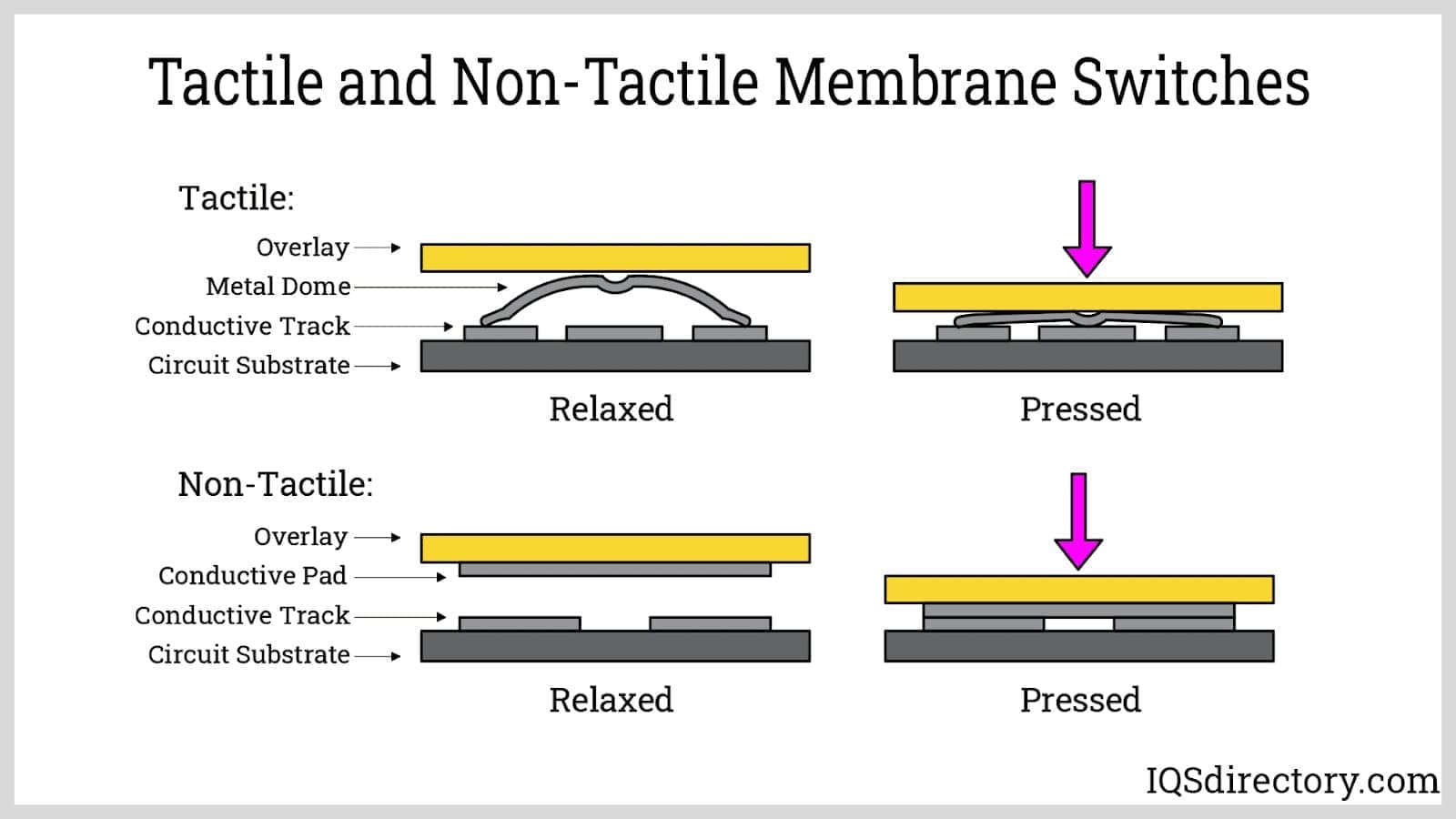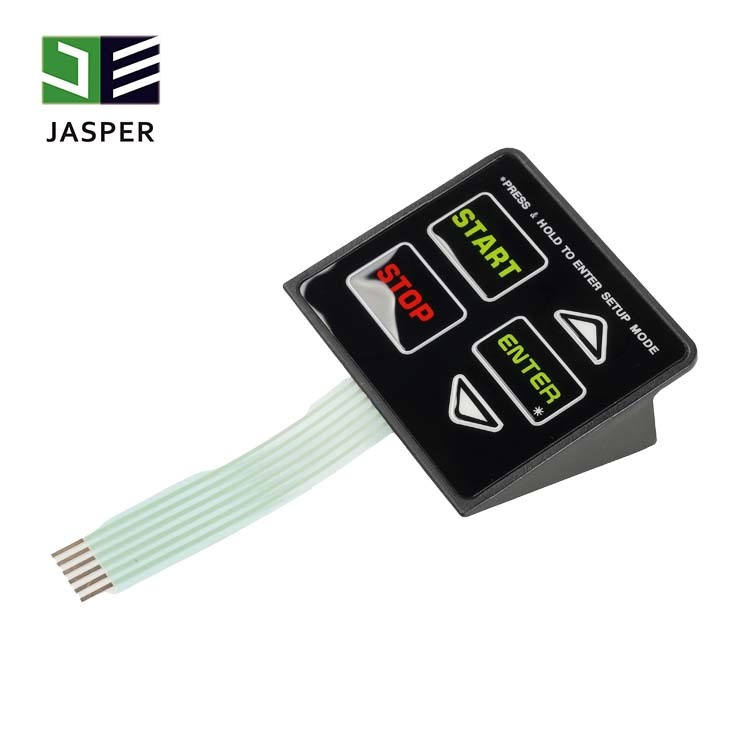Comprehending the Value of Membrane Switch in Modern Electronic Devices and Their Applications
Membrane switches serve as a vital element in modern-day electronic devices, providing an effective user interface for individual interaction. Their adjustable and lightweight nature makes them ideal for a series of applications across varied sectors. Comprehending their crucial components and benefits can give understandings into their growing significance. As technology remains to advancement, the advancement of Membrane switches raises questions concerning their future applications and layout developments. What lies ahead in this vibrant field?

What Are Membrane Buttons?
Membrane buttons are essential parts in modern electronic devices, functioning as user interfaces that facilitate communication between gadgets and users. These buttons consist of a number of layers, consisting of a graphic overlay, a glue layer, and a circuit layer, all of which work with each other to create a resilient and functional user interface. The style allows for a flat, inconspicuous remedy that can be customized concerning size, shape, and aesthetic appearance, making them suitable for numerous applications, from consumer electronics to medical tools. The responsive responses offered by Membrane switches over enhances user experience, while their resistance to dirt and wetness makes them suitable for challenging atmospheres. Moreover, Membrane buttons can incorporate attributes such as backlighting and printed graphics, better increasing their usability. Their flexibility and effectiveness make them a favored option in sectors where integrity and ease of use are vital, inevitably adding to the smooth procedure of modern-day digital gadgets.
Key Components of Membrane Switches
While numerous components add to the performance of a membrane layer button, three primary layers play considerable duties in its style and procedure. The leading layer, commonly made from a durable polymer, functions as the user interface for customer interaction, usually including published symbols and graphics. Under this is the spacer layer, which preserves the necessary distance between the top layer and the circuit layer. This spacer layer assurances that the button triggers just when pressed, avoiding unintended inputs. The circuit layer contains conductive traces that complete the electric circuit when the leading layer is dispirited. These traces can be made from different materials, consisting of copper or silver. With each other, these parts create a reputable and robust device that is small and versatile, ideal for a vast array of digital applications, from family home appliances to medical gadgets. Recognizing these vital parts is important for valuing the overall capability of Membrane buttons.
Benefits of Using Membrane Switches Over

Membrane Switch Production Process
Comprehending the Membrane button manufacturing procedure exposes the intricate actions involved in generating these necessary elements. The procedure normally begins with the style phase, where layouts and specs are created using specialized software application. Following this, the graphic overlay is printed on an adaptable substrate, commonly using high-resolution printing methods to assure clearness and precision.Next, the glue layers are applied, which serve to bond the numerous components together. The circuit layers, made from conductive inks or materials, are after that published onto a separate substratum. These layers are carefully lined up and laminated flooring to create a practical switch.After setting up, the buttons undergo checking to validate functionality and toughness. Quality assurance measures are carried out throughout the procedure to identify and correct any type of issues. The finished Membrane buttons are packaged and prepared for circulation, all set to meet the demands of contemporary electronic applications.
Applications of Membrane Switches Over in Numerous Industries
Membrane buttons are increasingly utilized across various industries, particularly in medical tools and consumer electronics. In the medical field, they provide reliable control user interfaces for devices that require specific procedure. In consumer electronics, these switches enhance user communication by supplying smooth and responsive user interfaces. Receptive Medical Equipment Control
Countless modern-day medical devices utilize Membrane switches for streamlined procedure and improved individual interaction. These buttons supply a trustworthy, long lasting interface for a selection of applications, consisting of diagnostic tools, individual surveillance systems, and surgical instruments. Their adjustable designs permit details formats that can accommodate the unique needs of medical care professionals, ensuring intuitive navigating and effective accessibility to important features. Furthermore, Membrane switches are immune to impurities, making them appropriate for sterilized environments. The responsive responses they use can boost user self-confidence, decreasing the risk of errors throughout important clinical procedures. Generally, the assimilation of Membrane buttons in medical Bonuses tools significantly adds to improved functional performance and person security in medical care settings.
Consumer Electronic Devices Interfaces
In the domain name of consumer electronic devices, Membrane switches play a vital function in boosting interface throughout a broad variety of tools. These buttons are essential to items such as push-button controls, microwaves, and pc gaming consoles, providing a efficient and easy to use user interface. Their layout permits a seamless combination of graphics and performance, making it possible for suppliers to create sleek, contemporary appearances without compromising usability. Membrane switches are likewise understood for their longevity, frequently enduring comprehensive use and exposure to different environmental conditions. Furthermore, they can integrate functions like about his backlighting and responsive comments, further enhancing the user experience. As consumer demands for advanced yet user-friendly interfaces grow, Membrane changes remain to be an essential part ahead of time digital gadget performance.
Style Considerations for Membrane Switches Over
Creating reliable Membrane switches over needs cautious attention to various variables that affect both performance and user experience. One vital factor to consider is the selection of materials, as they can impact durability, responsive comments, and aesthetic allure. Picking an appropriate adhesive is important for guaranteeing lasting bond and resistance to environmental factors.In enhancement, the design and design of the button should accommodate customer interaction, with switch sizes and spacing optimized for convenience of usage. The incorporation of graphics and labeling need to focus on clarity and presence under different lighting conditions.Consideration of electric qualities, such as actuation pressure and switch level of sensitivity, will boost the responsiveness of the Membrane switch. The layout needs to accommodate making processes to assure cost-effectiveness and timely production. Generally, a well-thought-out layout enhances both the capability and the user experience of Membrane buttons in modern electronics.

Future Patterns in Membrane Switch Modern Technology
As technology remains to advance, Membrane switches are poised to integrate new innovations that will certainly enhance their functionality and application in different areas. One substantial fad is the incorporation of long lasting and adaptable materials, which will certainly enhance the lifespan and dependability of these switches. Enhanced surface structures and adjustable graphics are additionally prepared for, permitting even more instinctive customer interfaces.Moreover, the integration of smart technology, such as touch-sensitive surfaces and haptic comments, is anticipated to enhance individual communication, making Membrane changes much more engaging and responsive. Additionally, advances in published electronic devices will certainly allow a lot more complex circuitry within thinner profiles, further broadening design possibilities.Sustainability will certainly likewise play a crucial function in future advancements, as makers explore environmentally friendly materials and manufacturing procedures. In general, these trends will certainly assure that Membrane switches remain appropriate and essential in a increasingly electronic and interconnected globe.
Frequently Asked Inquiries
Just How Do Membrane Changes Compare to Typical Mechanical Switches?
Membrane changes offer benefits over typical mechanical switches, consisting of minimized size, lighter weight, and boosted sturdiness. They generally give a sealed surface area, boosting resistance to dirt and wetness, making them perfect for varied applications.
What Materials Are Frequently Used in Membrane Switch Building?

Can Membrane Switches Withstand Extreme Environmental Conditions?
Membrane buttons can hold up against severe ecological problems, depending on their style and materials. High-grade constructions often include resilience against temperature level changes, humidity, and exposure to chemicals, making them ideal for numerous requiring applications throughout markets.
For How Long Do Membrane Switches Usually Last Before Failing?
Membrane changes commonly show a life expectancy varying click here for more from 1 to 10 million actuations, depending on aspects such as use frequency, environmental problems, and making quality. Routine maintenance can extend their longevity and operational integrity substantially.
Are Membrane Switches Over Customizable for Certain Applications?
Membrane switches are indeed adjustable for details applications. They can be tailored in size, functionality, and layout, permitting makers to fulfill special individual demands and boost item appearances while keeping functional effectiveness and resilience. Membrane switches are crucial parts in modern electronic devices, offering as user interfaces that assist in interaction in between devices and individuals. The responsive comments given by Membrane changes enhances user experience, while their resistance to dust and moisture makes them optimal for challenging environments. The unification of graphics and labeling need to focus on clarity and exposure under various lights conditions.Consideration of electric qualities, such as actuation pressure and button level of sensitivity, will certainly boost the responsiveness of the Membrane switch. Enhanced surface appearances and customizable graphics are also prepared for, allowing for more user-friendly customer interfaces.Moreover, the combination of wise modern technology, such as touch-sensitive surface areas and haptic comments, is expected to improve user interaction, making Membrane switches over more interesting and receptive. Membrane switches over offer advantages over standard mechanical switches, including lowered dimension, lighter weight, and improved resilience.